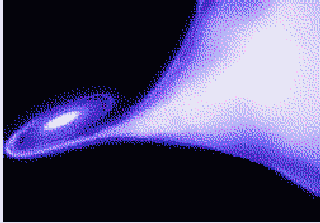


X-RAY BINARIES
X-ray binary stars are systems in which two stars are in a very close orbit about each other. One of the stars is an ordinary star, much like the Sun though it may be either more or less massive than the Sun. The other is a compact star - it may be a white dwarf, a neutron star or a black hole. Because the compact star is physically small but exceptionally dense, it exerts a strong force on matter in its vicinity, so it drags gas off the companion star which then falls at a high speed towards the compact star. This stream of gas forms a disc (the "accretion disc") about the compact star and becomes very hot in the process, so hot that it emits X-rays and becomes a powerful X-ray star. It is because the X-rays come from the disc, and not the compact star itself, that it is possible to see the X-rays even from a black hole.

IMAGE - An artist's impression of an accretion disc about a compact star, showing part of the surface of the companion star in the foreground. (With acknowledgments to the Space Science Laboratory, Marshal Space Science Center.)
X-ray binaries will be important targets for XMM. Sometimes we see the binary from a position where the accretion disc is eclipsed by the companion star as it moves around its orbit, so that once in each orbit the disc cannot be seen and the X-rays are cut off. Then we can measure the period of the orbit, from which may come the size of the system and possibly even the mass of the compact star. This may tell us whether it is a white dwarf, a neutron star or a black hole. The most massive stars can only be black holes.
All compact stars are formed when an ordinary star has used up its store of nuclear fuel. The compact star may be a white dwarf, which is about the size of the Earth, a neutron star, which is about 10 miles in diameter, or a black hole. White dwarfs and neutron stars are roughly similar in mass to the Sun (neutron stars a little more massive) but black holes are at least several times the mass of the Sun.

